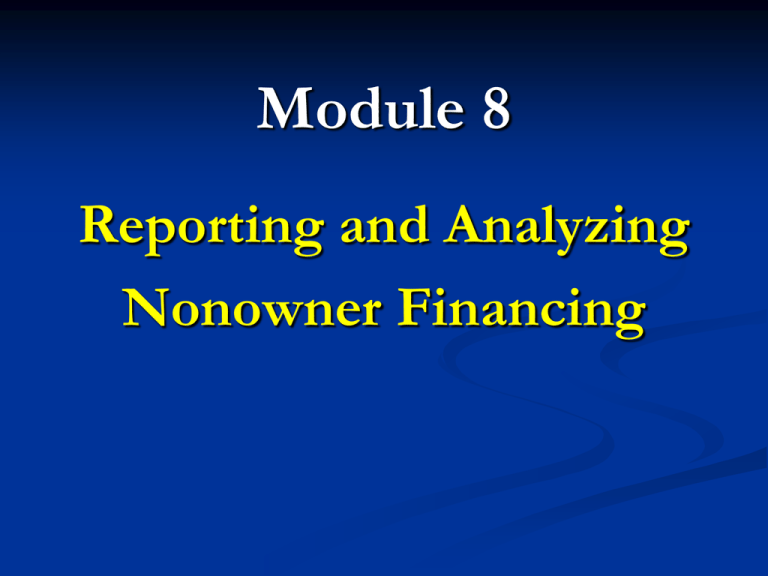Non-owner Financing
advertisement

Module 8 Reporting and Analyzing Nonowner Financing Current Liabilities - Operating Accounts payable - Obligations to others for amounts owed on purchases of goods and services; these are usually non-interestbearing. Accrued liabilities - Obligations for which there is no related external transaction in the current period. These include, for example, accruals for employee wages and taxes, as well as accruals for other liabilities such as rent, utilities, and insurance. Current Liabilities - Nonoperating Short-term interest-bearing loans - Short-term bank borrowings and notes expected to mature in whole or in part during the upcoming year; this item can include any accrued interest payable. Line of Credit – agreement with bank for a loan of up to a specific amount, typically fee of .05% up to .35% plus interest on any loan actually taken. Current maturities of long-term debt - Long-term liabilities that are scheduled to mature in whole or in part during the upcoming year. Accounts Payable Turnover and Days Payable Outstanding Uncertain Accruals A contingent liability is a potential liability whose occurrence and/or ultimate amount is dependent upon a future event. If the obligation is probable and the amount estimable, then a company will recognize this obligation. If only one of the criteria is met, the contingent liability is disclosed in the footnotes. Short-term Interest-Bearing Loans Companies generally finance seasonal swings in working capital with a bank line of credit. Bond Pricing – 2 Important Rates Coupon (contract or stated) rate - the coupon rate of interest is stated in the bond contract; it is used to compute the dollar amount of (semiannual) interest payments that are paid to bondholders during the life of the bond issue. Market (yield or effective) rate - this is the interest rate that investors expect to earn on the investment for this debt security; this rate is used to price the bond. Cash Flows from Bonds Assume that investors wish to price a bond with a face amount of $10 million, an annual coupon rate of 6% payable semiannually (3% semiannual rate), and a maturity of 10 years. Investors purchasing this issue will receive the following cash flows: Bond Pricing: Coupon Rate < Market Rate (Discount) Assume that investors expect an 8% annual yield (4% semi-annual yield). Given this discount rate, the bond will sell for $8,640,999 as below. The entry to record this: Cash Bond Discount Bonds Payable 8,640,999 1,360,001 10,000,000 Bond Pricing: Coupon Rate > Market Rate (Premium) Assume that investors expect only a 4% annual yield (2% semiannual yield). Given this new discount rate, the bond will sell for $11,635,129 as below. The entry to record this: Cash 11,635,129 Bonds Payable Bond Premium 10,000,000 1,635,129 Coupon Rate vs. Market Rate Effective Cost of Debt Sale at par - the effective cost to the company is the cash interest paid. Sale at a discount - the effective cost to the company includes both the cash interest paid and the discount. Sale at a premium - the effective cost to the company, then, is the cash interest paid less the premium amortization. Accounting for Bonds: Income Statement Interest expense in the income statement is the sum of two components: Amortization of the discount or premium: 1. Straight-line method: Divide the original amount by the number of periods. 2. Effective interest rate method: Interest expense is calculated as the beginning book value times the effective rate. The amortization will be the difference between interest expense and the cash payment. Gain (Loss) on Repurchase of Bonds Verizon’s L-T Debt Footnote Companies are required to present a schedule of debt maturities for each of the next 5 years: Debt Ratings Bond Interest Rates Factors Affecting Bond Ratings Moody’s Ratings Distributions Bond Terms Indenture: legal agreement between bond holders and company. Perpetuity: no due date. Zero coupon bond: risky bond that promises to pay the principal on the due date. Callable bond: bond may be called at the option of the issuer, normally for a premium. Convertible bond: bond is convertible into common stock at a fixed rate over the life of the bond. Global Accounting Under IFRS, companies can limit disclosure of contingent liabilities if doing so would severely prejudice the entity’s competitive or legal position. IFRS offers more disclosure of liabilities and accruals. Under IFRS, convertible debt is split into two parts: debt and equity (reflecting the option to convert). Results in a bond discount that is amortized.






